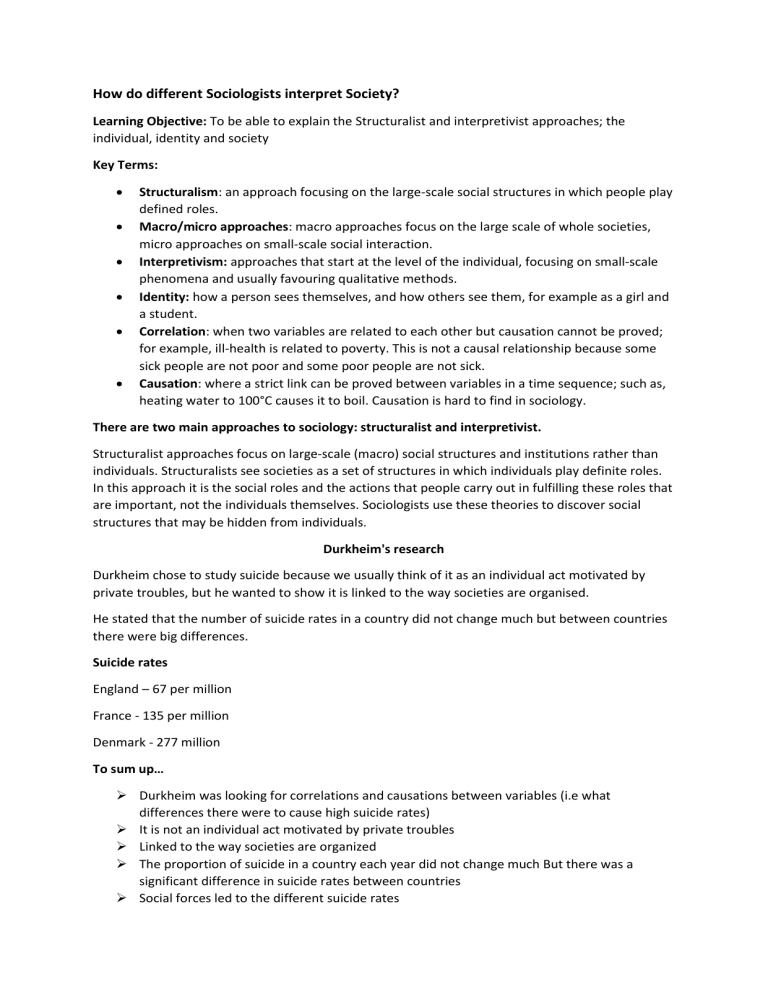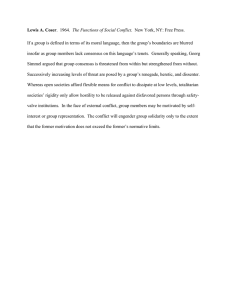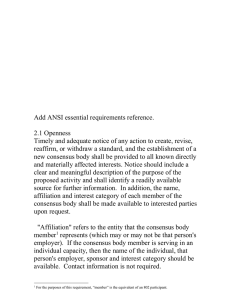Sociological Perspectives: Structuralism, Interpretivism, and More
advertisement

How do different Sociologists interpret Society? Learning Objective: To be able to explain the Structuralist and interpretivist approaches; the individual, identity and society Key Terms: Structuralism: an approach focusing on the large-scale social structures in which people play defined roles. Macro/micro approaches: macro approaches focus on the large scale of whole societies, micro approaches on small-scale social interaction. Interpretivism: approaches that start at the level of the individual, focusing on small-scale phenomena and usually favouring qualitative methods. Identity: how a person sees themselves, and how others see them, for example as a girl and a student. Correlation: when two variables are related to each other but causation cannot be proved; for example, ill-health is related to poverty. This is not a causal relationship because some sick people are not poor and some poor people are not sick. Causation: where a strict link can be proved between variables in a time sequence; such as, heating water to 100°C causes it to boil. Causation is hard to find in sociology. There are two main approaches to sociology: structuralist and interpretivist. Structuralist approaches focus on large-scale (macro) social structures and institutions rather than individuals. Structuralists see societies as a set of structures in which individuals play definite roles. In this approach it is the social roles and the actions that people carry out in fulfilling these roles that are important, not the individuals themselves. Sociologists use these theories to discover social structures that may be hidden from individuals. Durkheim's research Durkheim chose to study suicide because we usually think of it as an individual act motivated by private troubles, but he wanted to show it is linked to the way societies are organised. He stated that the number of suicide rates in a country did not change much but between countries there were big differences. Suicide rates England – 67 per million France - 135 per million Denmark - 277 million To sum up… Durkheim was looking for correlations and causations between variables (i.e what differences there were to cause high suicide rates) It is not an individual act motivated by private troubles Linked to the way societies are organized The proportion of suicide in a country each year did not change much But there was a significant difference in suicide rates between countries Social forces led to the different suicide rates For example: social forces such as: 1. support network 2. Families 3. Religious organisations To conclude Durkheim’s research… Strong connections lead to lower suicide rates and weak connections lead to higher rates. Suicide is a result of society as opposed to the individual Structuralist theories say individuals have little freedom even if they think they do Individuals are puppets and hidden social forces are pulling the strings that make individuals behave the way they do. Structuralists use positivist method: causation and correlations What is Interpretivism? In contrast, interpretivists start with the individual rather than society and focus on the micro rather than the macro scale. Interpretivists believe individuals are in control, pulling the strings of society. People make the societies they live in and change them through their actions. We are born into particular societies and learn the norms and values of the society we grow up in but we do not have to accept them, and the values themselves also change continuously over time as people’s ideas change. Interpretivists are interested in how individuals make sense of society and of social actions – the things that they do. Interpretivists start their study of society from the level of the individual, unlike structuralists. They are interested in how people see themselves and what makes up their identity (who we think we are). In all societies we are given labels, and these can be part of our identities. We choose among the identities that are socially available to us and reject others, and these labels carry different meanings for us. For instance, someone may see themselves primarily through their religious Identity or their age identity. Similarly, we may see other people in terms of labels that they might accept or reject. Socially available labels include: ■ Gender identities ■ ethnic identity – membership of an ethnic group ■ age ■ social class ■ nationality ■ occupation ■ roles within a family, such as parent ■ membership of a religious or political organisation Learning Objective: Explain how different sociological views (functionalist) on conflict and consensus create alternative perspectives. Key Terms: Perspectives: Ways of viewing social life from different points of view. Consensus: Basic agreement on a set of shared values. Conflict: Disagreement between groups with different interests. Bourgeoisie: The upper class Proletariat: working class Consensus and conflict One major difference between perspectives in sociology is the extent to which they emphasise either social consensus (in agreement) or social conflict (not in agreement). Social Consensus There is social consensus when people generally share values and there are no major disagreements between the main groups. This is possible only if either all the groups in a society have similar levels of wealth, status and power or if it is widely accepted that it is right for each group to have the level of wealth, status and power that it does. A society built on consensus will be stable and harmonious. The values that are shared may be based on a religion or a belief system, or perhaps on political ideas, and there are likely to be shared practices and rituals that bring everyone together and make them feel a sense of belonging, so they identify strongly with their society and its values. Social Conflict Social conflict occurs when major disagreements arise about important issues such as wealth, status and power. In a society based on conflict there will be significant and important differences between groups, which may become open conflicts, and there will be no overall set of shared values held by all groups. A society based on conflict will be unstable, though there may be long periods where one group in power is able to suppress others that challenge it. Functionalism The main sociological perspective based on a consensus view of society is functionalism. Functionalists emphasise social functions and ask, ‘What function does this aspect of society carry out that keeps this society stable and allows it to continue?’ Functionalists perceive human society as being like the human body. This is called the organic or biological analogy because it compares society to a living organism. The different parts of the human body – the brain, heart, liver, skin and so on – all have jobs to do to keep you healthy. In the same way, each part of society is seen as having functions that all help the society as a whole to be healthy and survive. If something goes wrong in one part of your body, it may affect other parts and it may be a warning sign that you need to do something. So, in a human society, an increase in crime might become a problem that needs to be tackled, perhaps by getting schools to be better at teaching people to obey the law. What do you think is the functions of schools? The function of schools is to give young people the skills they need for work, which helps the economy of a society Families The function of families is to socialise children into the norms and values of the society so that the next generation will have these values. Prisons The function of prisons is to remove temporarily from society people who do not keep the laws and who therefore upset the smooth running of society. Consensus theories believe people in society have shared interests and values No major disagreements between the main groups. Consensus is achieved if everyone in society has the same levels of wealth, status and power or if it is accepted for each group to have that level of wealth, status and power. A society built on consensus is harmonious and stable. The values that are shared maybe based on religion or a belief system, or perhaps on political ideas. Shared rituals and practices bring everyone together and a sense of belonging, so they identify strongly with their society and its values. Social conflict occurs when major disagreements arise about important issues such as wealth, status and power. In a society based on conflict there will a significant and important differences between groups, which may become open to conflicts. There will be no shared values held by groups. A society based on conflict will be unstable, though there may be long periods where one group in power is able to suppress others that challenge it. As interpretivists are more interested in (micro) social interaction than the overall nature of society, the debate about consensus and conflict does not apply to them. However, they are criticised for not taking into account wider issues such as power, which may influence the situations they study. Functionalist Perspective Talcott Parsons (1902-1979) Functionalists believe that society functions like the human body. Each organ in the body represents each institution in society. Without each of the organs (institutions) – society would not function. E.g., an increase in crime might need to be tackled by perhaps getting schools to teach people to obey the law. Marxist perspective Modern Industrial Societies are based on conflict between social classes. There is continuous conflict of interest between social classes in the form of strikes, protests by the working class that can lead toa revolution. Marxism refers to the two main classes as the bourgeoise (elite upper class) and the proletariat (working class). The bourgeoise exploit and oppress the proletariat who are ‘wage slaves’. This means the proletariat have no choice but to work if they are to survive but they are never paid fully for their work – the bourgeoise take their profit. Marxist VS Functionalist Perspective Functionalism look at parts of society and see how they keep society stable and harmonious. Marxists look at the same phenomena and see how the bourgeoise keep their wealth and power. Marxists might say for example: a) Schools ensure people fail so they accept low position in society b) The mass media distract people’s attention on what is really going on (make them interested in celebrities and sports) Feminism Key term: Feminism: any person who believes in the social, political, economic equality of all genders, regardless of race, ethnicity, socioeconomic, class, religion, ability. Feminists are another example of a ‘conflict theory’. They believe men exploit women within a range of institutions in society, e.g. family, workforce, education. Feminists believe society is patriarchal – dominated by men. From a feminist perspective, men get the greatest benefit from family life, while women have to have the children and provide the childcare and domestic labour (housework). Men still earn more money, despite the narrowing of pay gaps and high-status positions. In politics, Britain has only ever had 2 female prime ministers and women did not gain the right to vote on the same basis as men (at the age of 21) until 1928. Equal Pay and gender Discrimination laws were not introduced until the 1970’s. Some feminists believe women have always been second-class members of a patriarchal society. Some argue that social/cultural differences are the reason for our gender roles e.g., polygamy (having more than one spouse at a time) in order to exploit the labour of women. There are different types of feminists which have the same purpose but aim to achieve it in different ways e.g.: LIBERAL FEMINISTS – Achieve equality through the law – e.g., Equal Pay Act, Gender Discrimination Act RADICAL FEMINISTS – Use protests and campaign for radical change, e.g., women to leave men and live-in female households


